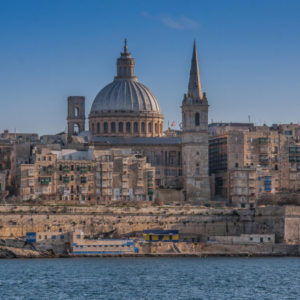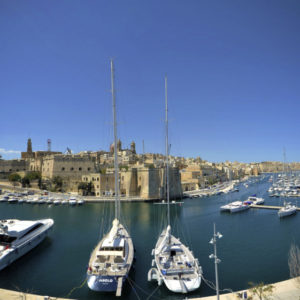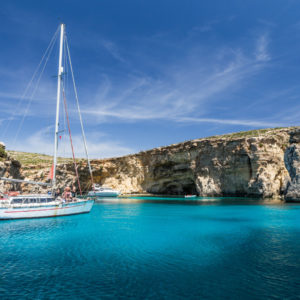Information, Videos and Photos courtesy of VisitMalta
Megaliths, medieval dungeons and Calypso’s Cave – The Maltese Islands are positively mythic. The narrow meandering streets of their towns and villages lead to the main square, which is invariably dominated by the huge baroque church. As the countryside is dotted with medieval towers, wayside chapels and the oldest known human structures in the world, the Islands have rightly been described as an open-air museum.
The Maltese archipelago lies virtually at the center of the Mediterranean, 93 km south of Sicily and 288 km north of Africa. The archipelago consists of three islands: Malta, Gozo and Comino with a total population of over 400,000 inhabitants occupying an area of 316 square kilometers.
Malta is the largest island and the cultural, commercial and administrative center. Gozo is the second largest island and is more rural, characterized by fishing, tourism, crafts and agriculture. Comino, the smallest of the trio, has one hotel and is largely uninhabited.
With superbly sunny weather, attractive beaches, a thriving nightlife and 7,000 years of intriguing history, there is a great deal to see and do.
Here you can span the millennia with an astonishing array of things to discover. And wherever you go, the scenery and architecture provide a spectacular backdrop. The colors are striking, honey-colored stone against the deepest of Mediterranean blues.
Malta has been described as one big open-air museum. What makes it unique is that so much of the past is visible today. Delve into the island’s mysterious prehistory, retrace the footsteps of St. Paul or see where the Knights of St. John fought their most famous battles.
Malta is holidaying as the mood takes you. And with near year-round sun, you can indulge in outdoor living at its best.
The North, the most rugged of all Malta’s regions, offers spectacular views across to Comino and Gozo. It also has Malta’s most established beach and holiday resorts, Buġibba, Qawra, St. Paul’s Bay, and Malta’s largest sandy beach at Mellieħa. Also northwards are Malta’s other larger sandy bays, Golden Bay, Għajn Tuffieħa and Paradise Bay.
Sliema and St. Julian’s are Malta’s main coastal resort towns and a heartland for shopping, entertainment and café life. They also house some of Malta’s newest hotels and apartments. St. Julian’s and Paceville are Malta’s main nightlife areas.
The South is characterized by its fishing villages and quiet bays. It offers an authentic insight into Maltese rural life. It is also the location of two of Malta’s prehistoric temples, Ħagar Qim and Mnajdra. The region is largely undeveloped. Most hotels are in the harbour town of Marsaskala, a southern resort which bustles by night yet is charming and quiet by day.
Central Malta is dominated by Malta’s ancient capital, Mdina, a near perfect example of a medieval walled town. Beyond the walls, lies Rabat, a large town of Roman origin. The central region has some of the most interesting inland options, ranging from palaces to town house hotels.
Malta’s sister islands of Gozo and Comino provide a tranquil haven and scene change. Greener, more rural and smaller than Malta, life on Gozo moves at a leisurely pace. Accommodation options here range from charming old farmhouses, often with private pools, to five-star hotels and apartments with spectacular sea views, to secluded hotels with stone trulli and cottages as guest quarters.
Tiny Comino is the ultimate escape, all year round. Car-free and carefree, it has just the one resort hotel but it makes an excellent choice for those who want seclusion or to make the most of water sports.
Valletta has many titles, all recalling its rich historical past. It is the “modern” city built by the Knights of St John; a masterpiece of the Baroque; a European Art City and a World Heritage City. Today, it is one of the most concentrated historic areas in the world.
The city is busy by day, yet retains a timeless atmosphere by night, that gives the feeling that you are walking back in time. The grid of narrow streets boasts some of Europe’s finest art works, churches and palaces.
Valletta is abundantly rich in sites to see and explore, intriguing historical buildings around every corner: votive statues, niches, fountains and coats of arms high up on parapets. Narrow side streets are full of tiny quaint shops and cafés, while Valletta’s main streets are lined with larger international branded shops for fashion, music, jewellery and much more.
The best way to get around and see the most, from your visit to Valletta, is on foot and although the things to do & see are many, a good start and definitely not to be missed are Valletta’s beautiful gardens. The Upper Barrakka Gardens, Hastings Gardens & the Lower Barrakka Gardens are just three of the most popular ones, however on further exploration many more hidden gardens can be discovered. From the Upper Barrakka Gardens it is also possible to see the Saluting Battery as well as take the lift down the bastions to sea level.
St John’s co-Cathedral & museum are definitely not to be missed, this elaborately adorned church is home to world famous artistic masterpieces by Caravaggio and Mattia Preti. Apart from beautiful Baroque churches other places of interest include the various grandmaster auberges, piazzas & museums.
Mdina’s Main City GateMdina has had different names and titles depending on its rulers and its role but its medieval name describe it best – ‘Citta’ Notabile’: the noble city.
It was home then, as now, to Malta’s noble families; some are descendants of the Norman, Sicilian and Spanish overlords who made Mdina their home from the 12th century onwards. Impressive palaces line its narrow, shady streets.
Mdina is one of Europe’s finest examples of an ancient walled city and extraordinary in its mix of medieval and baroque architecture.
Like nearby Mdina, Rabat played a major role in Malta’s past and is a prime source of its cultural heritage.
This large provincial township was part of the Roman city of Melita, with the sites and archaeological relics found testifying to the town’s importance during the Roman period.
For many centuries, religious orders have established themselves within the precincts of Rabat and Franciscans, Dominicans and Augustinians still flourish here in their spacious convents and monasteries, catering for the religious needs of parishioners in their churches.
The town is a commercial centre and acts as a market to its large agricultural hinterland. It is also well established on the tourist map due to its archaeological and historical sites: The Roman Villa (Domus Romana), catacombs, St. Paul’s Grotto and the fine churches and monasteries.
Steeped in myth, Gozo is thought to be the legendary Calypso’s isle of Homer’s Odyssey – a peaceful, mystical backwater. Baroque churches and old stone farmhouses dot the countryside. Gozo’s rugged landscape and spectacular coastline await exploration with some of the Mediterranean’s best dive sites.
The island also comes complete with historical sites, forts and amazing panoramas, as well as one of the archipelago’s best-preserved prehistoric temples, Ġgantija.
Gozo also possesses a nightlife and cultural calendar all of its own, with some great dining out.
Only 3.5 square kilometers, Comino is car-free and apart from one hotel, is virtually uninhabited.
The island’s main attraction is the Blue Lagoon. In summer, this sheltered inlet of shimmering aquamarine water over white sand is very popular with day-trippers. Other beaches on the island include Santa Marija Bay and San Niklaw Bay.
Comino is also worth a visit in winter, and is ideal for walkers and photographers. With no urban areas or cars on the island, one can easily smell the scent of wild thyme and other herbs.
Summers are hot, dry and very sunny. Day-time temperatures in summer are often mitigated by cooling sea breezes.
Spring and autumn are cooler, except when the occasional Scirocco wind from Africa brings unseasonably high temperatures and humidity.
Winters are mild, with the occasional short cold spells brought about by the north and north-easterly winds from central Europe.
Annual rainfall is low, averaging 568mm a year. Bathing in the sea is quite possible well into the ‘winter’ months, and the peak beach season can last until mid- to late October.
Showing all 3 results



